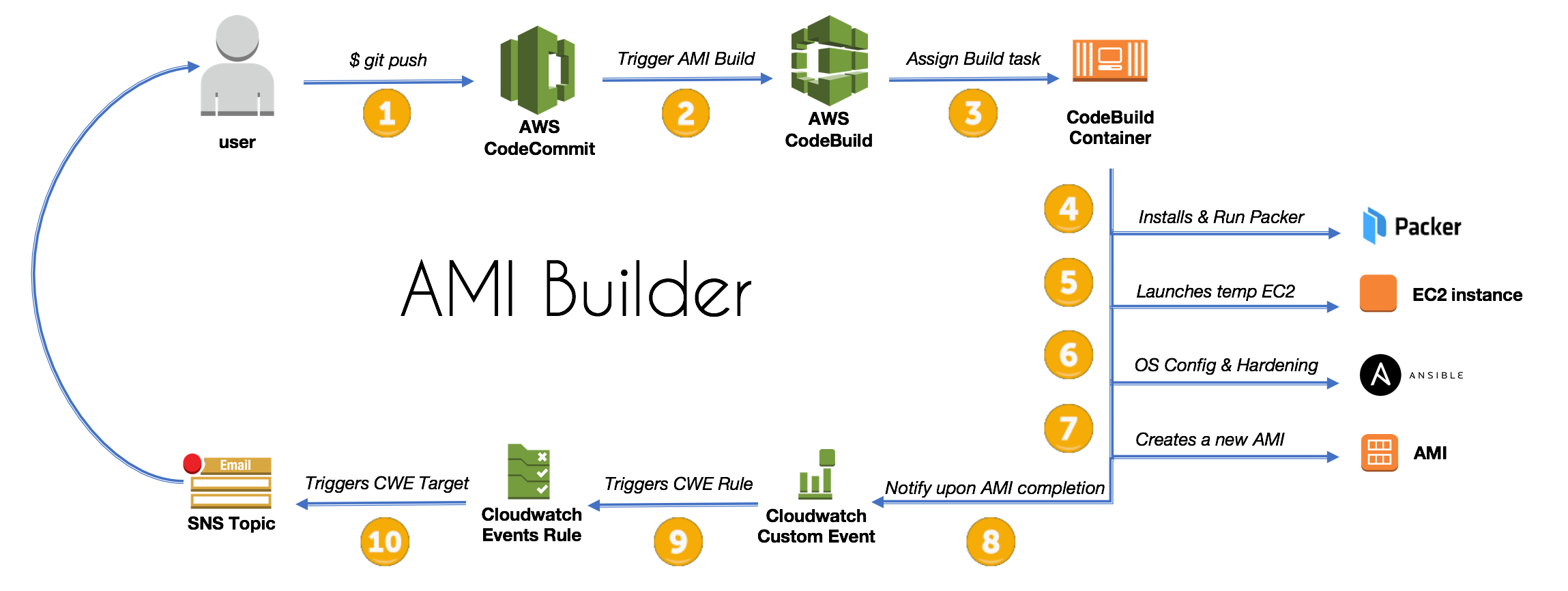This Packer AMI Builder creates a new AMI out of the latest Amazon Linux AMI, and also provides a cloudformation template that leverages AWS CodePipeline to orchestrate the entire process.
├── ansible
│ ├── playbook.yaml <-- Ansible playbook file
│ ├── requirements.yaml <-- Ansible Galaxy requirements containing additional Roles to be used (CIS, Cloudwatch Logs)
│ └── roles
│ ├── common <-- Upgrades all packages through ``yum``
├── buildspec.yml <-- CodeBuild spec
├── cloudformation <-- Cloudformation to create entire pipeline
│ └── pipeline.yaml
├── packer_cis.json <-- Packer template for PipelineCloudformation will create the following resources as part of the AMI Builder for Packer:
cloudformation/pipeline.yaml- AWS CodeCommit - Git repository
- AWS CodeBuild - Downloads Packer and run Packer to build AMI
- AWS CodePipeline - Orchestrates pipeline and listen for new commits in CodeCommit
- Amazon SNS Topic - AMI Builds Notification via subscribed email
- Amazon Cloudwatch Events Rule - Custom Event for AMI Builder that will trigger SNS upon AMI completion
Before you start
- Install GIT if you don't have it
- Make sure AWS CLI is configured properly
- Configured AWS CLI and Git to connect to AWS CodeCommit repositories
Launch the Cloudformation stack
| Region | AMI Builder Launch Template |
|---|---|
| N. Virginia (us-east-1) |  |
| Ireland (eu-west-1) |  |
| London (eu-west-2) |  |
To clone the AWS CodeCommit repository (console)
- From the AWS Management Console, open the AWS CloudFormation console.
- Choose the AMI-Builder-Blogpost stack, and then choose Output.
- Make a note of the Git repository URL.
- Use git to clone the repository. For example: git clone https://git-codecommit.eu-west-1.amazonaws.com/v1/repos/AMI-Builder_repo
To clone the AWS CodeCommit repository (CLI)
# Retrieve CodeCommit repo URL
git_repo=$(aws cloudformation describe-stacks --query 'Stacks[0].Outputs[?OutputKey==`GitRepository`].OutputValue' --output text --stack-name "AMI-Builder-Blogpost")
# Clone repository locally
git clone ${git_repo}Next, we need to copy all files in this repository into the newly cloned Git repository:
- Download ami-builder-packer ZIP.
- Extract and copy the contents to the Git repo
Lastly, commit these changes to your AWS CodeCommit repo and watch the AMI being built through the AWS CodePipeline Console:
git add .
git commit -m "SHIP THIS AMI"
git push origin masterCurrently, Packer doesn't work with ECS IAM Roles (also used by CodeBuild)That's why we build a credentials file that leverages temporary credentials in thebuildspecWhen Packer supports this feature, this will no longer be necessary
- If Build process fails and within AWS CodeBuild Build logs you find the following line
Timeout waiting for SSH., it means either- A) You haven't chosen a VPC Public Subnet, and therefore Packer cannot connect to the instance
- B) There may have been a connectivity issue between Packer and EC2; retrying the build step within AWS CodePipeline should work just fine

